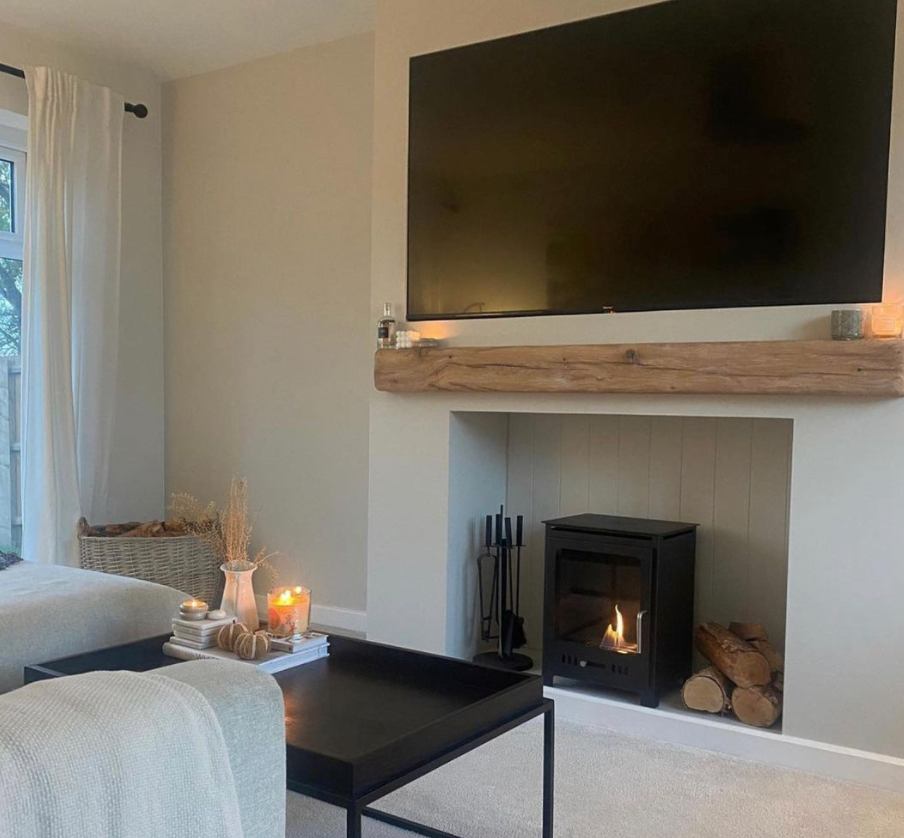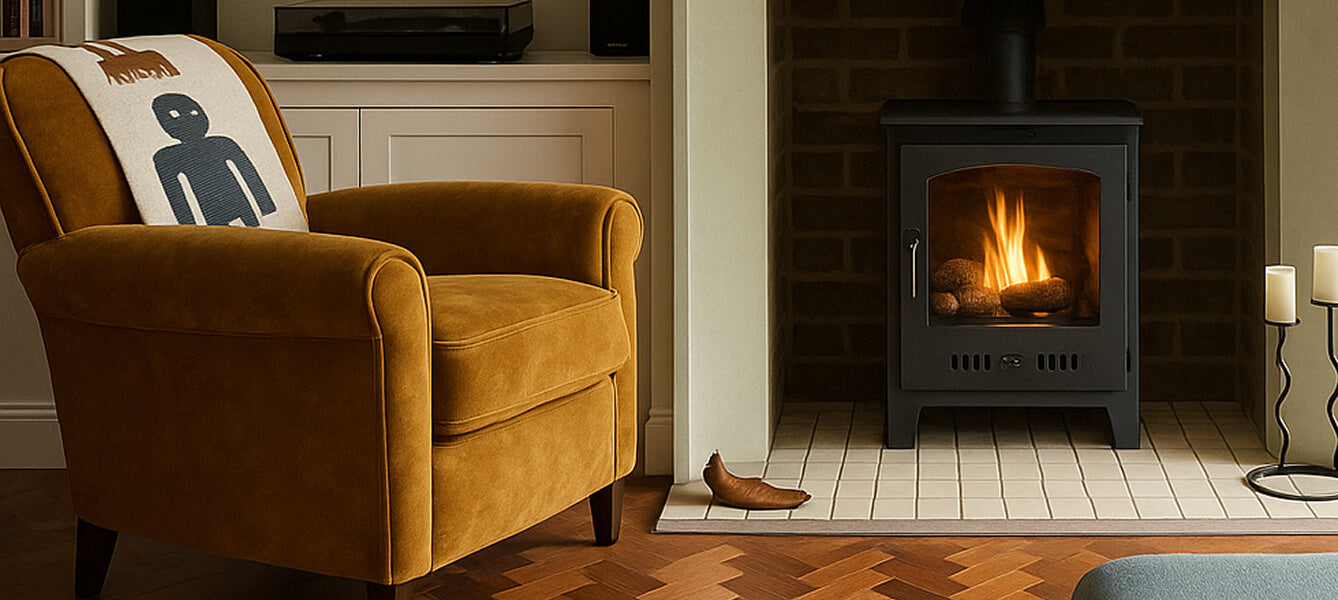
Eco-Friendly Home Decor Ideas for Ethical Houses
Are you looking for an eco-friendly way to decorate your home?
Maybe you're in the process of renovating an old property and thinking about installing a wood burner in that unused fireplace? But perhaps you're concerned about the environmental impacts of your home decor makeover?
Whichever way you look at it, home decor can be pretty environmentally disastrous. Not even the humble tin of paint gets away scot-free.
Fear not, as this article is all about eco-friendly home decor ideas, helping you transform your home without the existential guilt.

Let’s get started.
The environmental impacts of DIY
While this is by no means an exhaustive list, we wanted to demonstrate how tricky it can be to find genuinely eco-friendly and sustainable decor.
So, we're going to look at the standard environmental warnings that accompany the typical DIY project, with a range of affordable eco-friendly solutions.
1. Paint
You might think that paint has a relatively low impact on the environment and, compared to other DIY essentials, it's low-ish.
But:
Most paints are composed of four compounds: solvents, binders, pigments, and additives.
And while there's a plethora of harm to be found in binders, pigments, and additives, it's the solvents (which give your paint its spreadable consistency) that cause the most immediate environmental harm.
Oil-based paints use oils, alcohols, and other harmful compounds as solvents, which evaporate into the air as the paint dries. This releases Volatile Organic Compounds (VOCs), which react with sunlight, contributing to ozone formation and smog.
However, the most commonly used solvents in water-based household paints are water or other organic solvents. In general, water-based solvents release far fewer VOCs than oil-based paints, so opt for water- and latex-based paints for a more eco-friendly home decor approach.
Think:
- Does that wall really need repainting?
- Buy the right amount of paint
- Work with water- and latex-based paints
- Avoid paints with toxic ingredients and heavy metals
And if you’re considering THE most eco-friendly approach, consider using blended, remanufactured paint - made from leftover paint that would otherwise end up in the domestic waste stream.
2. Wallpaper
You’d think that wallpaper is a simple, eco-friendly way to decorate your house - but think again.
Wallpaper often contains PVC, which - over time - leaks VOCs into your room and the atmosphere. Not to put too fine a point on it, but HealthyStuff discovered that - from over 2300 wallpapers from 11 different manufacturers - 96% of them contained PVC coatings.

PVC has a shocking range of health implications, from respiratory problems, drowsiness, and issues with your eyes to liver cancer and negative impacts on the musculoskeletal- and nervous systems. And PVC coatings on wallpapers release VOCs that affect the air that we all breathe.
So, when choosing your wallpaper, look for those that don't contain PVC. Look for the Greenguard certification on the label.
And opt for water-based inks, recycled wallpapers, or those made from renewable sources, such as cork.
Look for Forest Stewardship Council (FSC) certification, confirming that the wallpaper has been manufactured using sustainable sources.
3. Carpets
Carpets transform the feel and finish of a room. But it's difficult to sweep the environmental impact of carpets under the rug (apols for the dad joke, there). It might be soft underfoot, but it's pretty rough on the environment (again).
Carpets are often treated with chemicals that release VOCs, and we throw away 400,000 tonnes of carpets in the UK every single year. That's enough to cover the whole city of Birmingham; every year.
And most carpets are made from synthetic fibres, such as nylon, polyester, and olefin, which take thousands of years to decompose in landfill.
But:
There is a way ahead: eco-friendly carpet made from natural and renewable fibres, such as seagrass, organic cotton, coir, jute, bamboo, and organic wool.
These materials are all plant-based, require very little fertiliser/pesticide to grow them, and are fully biodegradable.
Recycled carpets are also a thing! Made from post-consumer plastics, such as PET bottles and industrial scraps, they provide the same duration of wear as standard carpets. And they're usually downcycled into furniture stuffing or insulation when they wear out.
Some eco-friendly carpet companies provide a Take-Back programme. This means that you send your used carpet back to the manufacturer when you've finished with it, and they turn it into a new carpet or downcycle it into something useful.
And sometimes we throw a carpet away because the colour doesn't match the new scheme. This is super-wasteful because good quality carpets can be re-dyed.
4. Unused fireplaces and fossil fuels
It feels like a bit of a bonus when you discover a beautiful old fireplace during your renovation, but can we honestly say that we live in an ethical house if we're burning fossil fuels?
Many power companies, such as Ovo, Ecotricity, and Green Energy UK, provide carbon-neutral power tariffs. These often include planting trees to offset your home's carbon footprint.

But what do we do with that unused fireplace?
Most of us love the cosiness of an open fire, but with headlines like: Wood burners should have health warning, scientists say and Avoid using wood burning stoves if possible, warn health experts, it’s difficult to justify.
So, does that mean that an old unused fireplace should STAY unused? Of course, it's nice to have an old Victorian fireplace just for show, but this is missing a trick.
The Impact of Woodburners
Wood-burning stoves are gorgeous to look at and create an immediate homely feel.
But:
Wood burner efficiency is relatively low in comparison with burning bioethanol fuels.
A traditional open fire achieves around 15% fuel efficiency - that's because most of the heat is lost through the chimney. However, a wood-burning stove is more efficient, at around 70-80%, but it still loses a lot of its heat through its flue.
Wood burners built after 2021 must comply with Ecodesign regulations, making them up to 90% efficient - as long as you use wood with less than 20% moisture.
Nonetheless, you're still heating your home with a fuel that pollutes the atmosphere - it's just not very eco-friendly and certainly not a low carbon approach to heating your home.
Woodburners vs Bioethanol fireplaces
Woodburners are attractive to look at and create the warmth and homeliness we all crave. But it isn't easy to regulate the heat, and you often find yourself opening the windows to cool the room down.
Bioethanol fireplaces offer the homeliness of a real flame and come in a range of both uber-modern and traditional designs.

But, importantly, they don't produce the same amount of heat as a wood burner, which is helpful because you won't be running for the windows whenever you light it.
Most bioethanol fireplaces allow you to regulate the heat accurately. So, if it gets too warm, you simply adjust the flame height by reducing or increasing the gap in the fuel box by using the supplied closing tools.
And because we're focusing on eco-friendly credentials, it's good to note that bioethanol fireplaces don't require a chimney or a flue, so the heat produced stays in the room.
A bioethanol fireplace gives off around 3kWh (kilowatt-hours) of heat when it’s running at full. As a comparison, an average electric fire gives off around 2kWh.
Bioethanol is a by-product of crops such as corn and sugarcane and is considered environmentally friendly because it burns cleanly and doesn't pollute the atmosphere.
So, you don’t need to waste that unused fireplace. Think about using bioethanol as your eco-friendly alternative to a wood burner.
Sustainable decor
Eco-friendly, sustainable home decor IS possible.
Think about upcycling old furniture; go for water-based paints; consider green wallpapers and sustainable carpets; buy plant-based products - they give off fewer VOCs; and choose bioethanol rather than wood.
Sure, it might mean shopping around a little more, but if you want an ethical house, it’s worth the extra research.
Thanks for reading.
